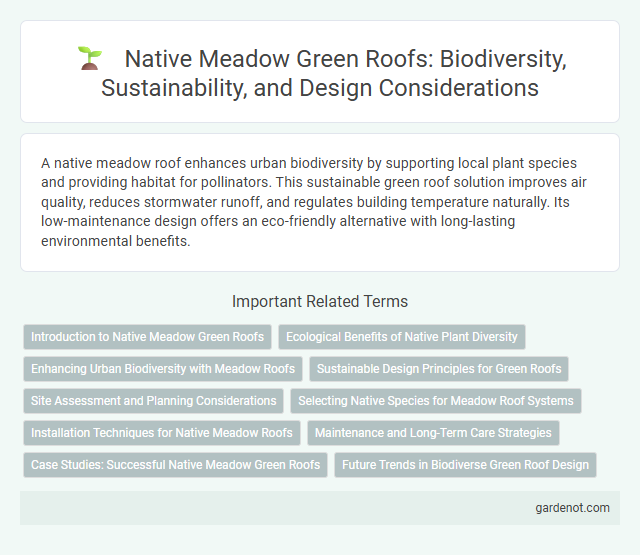A native meadow roof enhances urban biodiversity by supporting local plant species and providing habitat for pollinators. This sustainable green roof solution improves air quality, reduces stormwater runoff, and regulates building temperature naturally. Its low-maintenance design offers an eco-friendly alternative with long-lasting environmental benefits.
Introduction to Native Meadow Green Roofs
Native meadow green roofs utilize indigenous plant species such as wildflowers, grasses, and sedums to create sustainable, low-maintenance rooftop ecosystems. These roofs improve urban biodiversity, support pollinators, and enhance stormwater management by mimicking natural meadow environments. Incorporating native vegetation reduces irrigation needs and fosters resilience to local climate conditions, making native meadow roofs an eco-friendly alternative to traditional green roofing systems.
Ecological Benefits of Native Plant Diversity
Native meadow roofs enhance urban biodiversity by supporting a wide array of indigenous flora and fauna, creating vital habitats for pollinators like bees and butterflies. The diverse plant species improve ecosystem resilience, promote natural pest control, and contribute to better air quality through increased carbon sequestration. These roofs also aid in stormwater management by enhancing soil permeability and reducing runoff, thus preserving local water cycles.
Enhancing Urban Biodiversity with Meadow Roofs
Native meadow roofs support urban biodiversity by providing habitat for pollinators, birds, and beneficial insects, promoting ecosystem balance in city environments. These roofs utilize indigenous grasses and wildflowers that are adapted to local climates, enhancing resilience and reducing maintenance needs. Incorporating native meadow vegetation on rooftops contributes to urban green corridors, fostering connectivity between fragmented habitats.
Sustainable Design Principles for Green Roofs
Native meadow roofs enhance sustainable design principles by using indigenous plant species that require minimal irrigation and fertilizers, reducing water consumption and chemical runoff. These roofs improve urban biodiversity by providing habitat for local pollinators and birds, supporting ecological balance within city environments. Incorporating native vegetation also optimizes stormwater management by increasing infiltration and reducing runoff, contributing to resilient urban infrastructure.
Site Assessment and Planning Considerations
Site assessment for native meadow roofs involves evaluating soil type, drainage, sunlight exposure, and local climate to ensure optimal plant growth and structural support. Planning considerations include selecting native plant species adapted to the environment, assessing load-bearing capacity of the roof, and designing for adequate irrigation and maintenance access. Incorporating these factors enhances biodiversity, stormwater management, and thermal insulation benefits of the green roof system.
Selecting Native Species for Meadow Roof Systems
Selecting native species for meadow roof systems enhances biodiversity, supports local ecosystems, and improves plant resilience to regional climate conditions. Native grasses and wildflowers adapted to local soil, rainfall, and temperature patterns reduce maintenance needs and promote sustainable green roof performance. Incorporating species such as purple coneflower, little bluestem, and black-eyed Susan ensures optimal growth and ecological benefits on native meadow roofs.
Installation Techniques for Native Meadow Roofs
Installation techniques for native meadow roofs involve preparing a robust waterproof membrane and installing a specialized root barrier to protect the building structure. A lightweight, nutrient-poor growing medium optimized for native meadow plants is layered to promote deep root growth and natural drainage. Proper irrigation systems and erosion control measures are essential during establishment to ensure the long-term viability of the diverse native meadow ecosystem.
Maintenance and Long-Term Care Strategies
Native meadow roofs require minimal maintenance compared to traditional green roofs but benefit from seasonal inspections to manage invasive species and promote native flora growth. Long-term care strategies include targeted weeding, periodic mowing to mimic natural meadow succession, and soil health monitoring to sustain biodiversity and plant resilience. Incorporating adaptive management practices ensures the native meadow roof thrives under changing environmental conditions while maximizing ecological and aesthetic benefits.
Case Studies: Successful Native Meadow Green Roofs
Case studies of native meadow green roofs demonstrate significant ecological benefits, such as enhanced biodiversity and habitat creation for pollinators including bees and butterflies. Projects like Chicago's City Hall and Vancouver Convention Centre showcase how native plants reduce stormwater runoff by up to 75%, improving urban water management. These successful implementations highlight native meadow roofs' resilience, requiring minimal irrigation and maintenance while supporting local ecosystems.
Future Trends in Biodiverse Green Roof Design
Native meadow roofs represent an emerging trend in biodiverse green roof design, integrating diverse indigenous plant species to enhance urban ecosystems and support pollinator populations. Recent developments emphasize adaptive planting strategies that improve resilience to climate change, optimize stormwater management, and increase habitat complexity. Future designs prioritize ecological connectivity, promoting urban biodiversity while delivering sustainable environmental benefits in dense cityscapes.
Native meadow roof Infographic

 gardenot.com
gardenot.com